wheel CHRYSLER CROSSFIRE 2008 1.G Owner's Manual
[x] Cancel search | Manufacturer: CHRYSLER, Model Year: 2008, Model line: CROSSFIRE, Model: CHRYSLER CROSSFIRE 2008 1.GPages: 358, PDF Size: 4.7 MB
Page 192 of 358
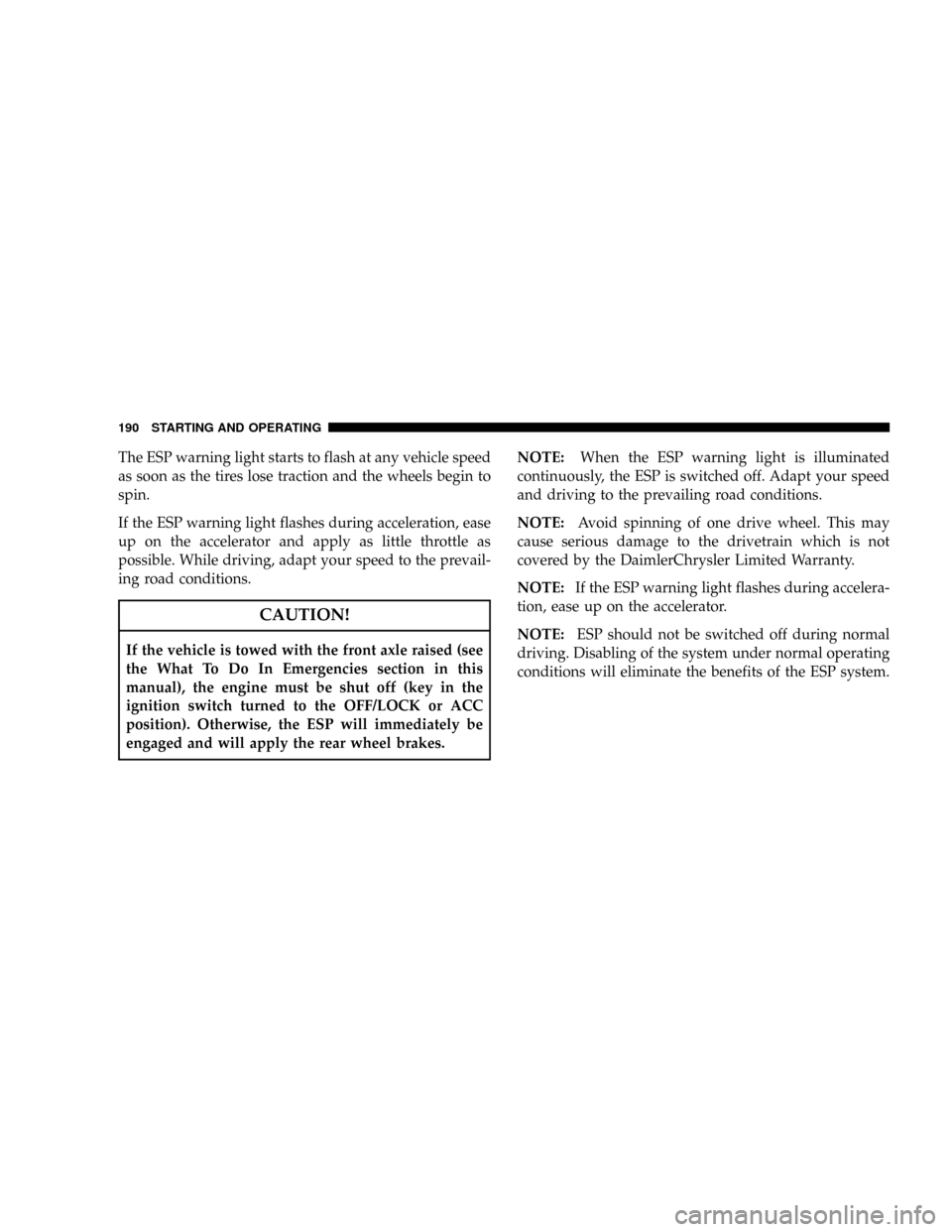
The ESP warning light starts to flash at any vehicle speed
as soon as the tires lose traction and the wheels begin to
spin.
If the ESP warning light flashes during acceleration, ease
up on the accelerator and apply as little throttle as
possible. While driving, adapt your speed to the prevail-
ing road conditions.
CAUTION!
If the vehicle is towed with the front axle raised (see
the What To Do In Emergencies section in this
manual), the engine must be shut off (key in the
ignition switch turned to the OFF/LOCK or ACC
position). Otherwise, the ESP will immediately be
engaged and will apply the rear wheel brakes.NOTE:When the ESP warning light is illuminated
continuously, the ESP is switched off. Adapt your speed
and driving to the prevailing road conditions.
NOTE:Avoid spinning of one drive wheel. This may
cause serious damage to the drivetrain which is not
covered by the DaimlerChrysler Limited Warranty.
NOTE:If the ESP warning light flashes during accelera-
tion, ease up on the accelerator.
NOTE:ESP should not be switched off during normal
driving. Disabling of the system under normal operating
conditions will eliminate the benefits of the ESP system.
190 STARTING AND OPERATING
Page 193 of 358
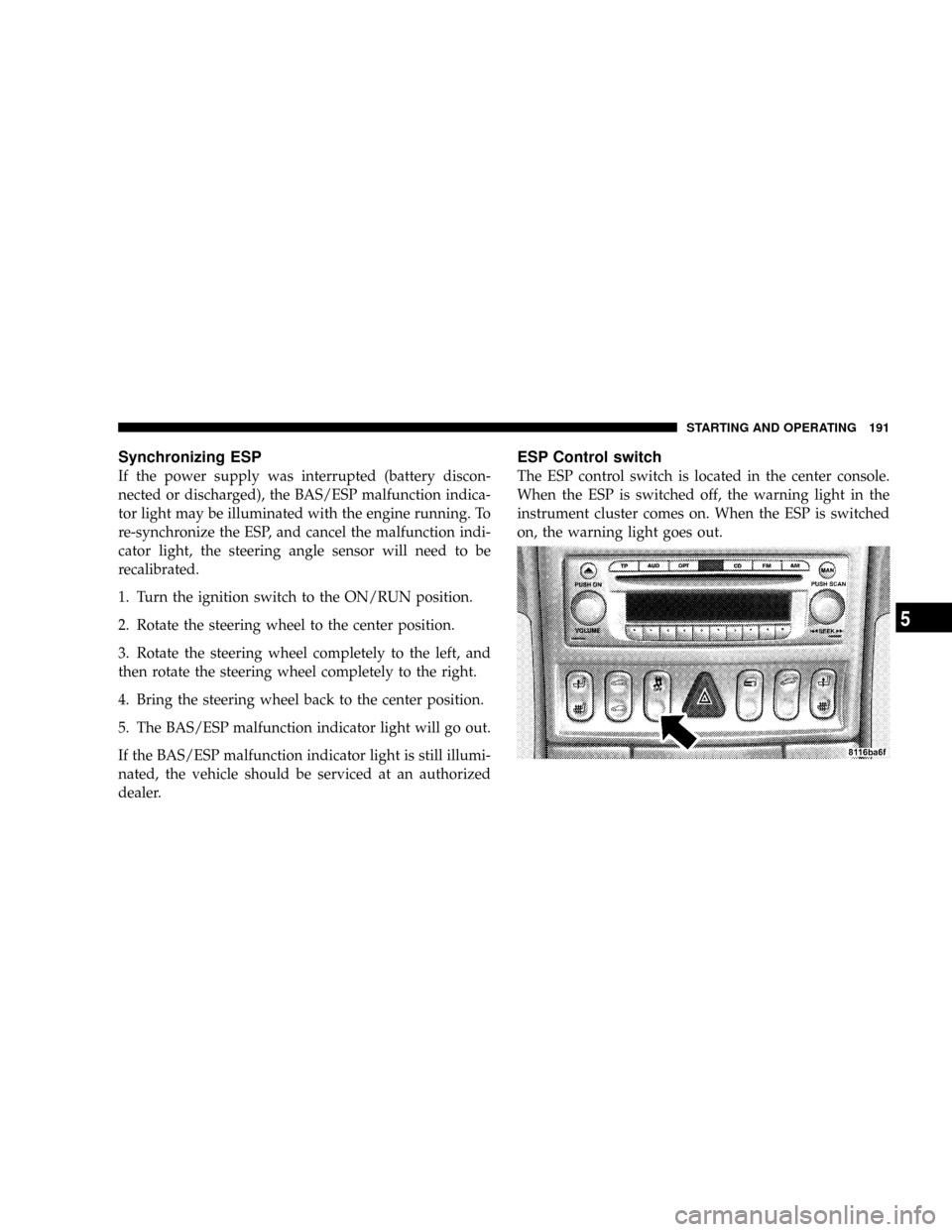
Synchronizing ESP
If the power supply was interrupted (battery discon-
nected or discharged), the BAS/ESP malfunction indica-
tor light may be illuminated with the engine running. To
re-synchronize the ESP, and cancel the malfunction indi-
cator light, the steering angle sensor will need to be
recalibrated.
1. Turn the ignition switch to the ON/RUN position.
2. Rotate the steering wheel to the center position.
3. Rotate the steering wheel completely to the left, and
then rotate the steering wheel completely to the right.
4. Bring the steering wheel back to the center position.
5. The BAS/ESP malfunction indicator light will go out.
If the BAS/ESP malfunction indicator light is still illumi-
nated, the vehicle should be serviced at an authorized
dealer.
ESP Control switch
The ESP control switch is located in the center console.
When the ESP is switched off, the warning light in the
instrument cluster comes on. When the ESP is switched
on, the warning light goes out.
STARTING AND OPERATING 191
5
Page 194 of 358
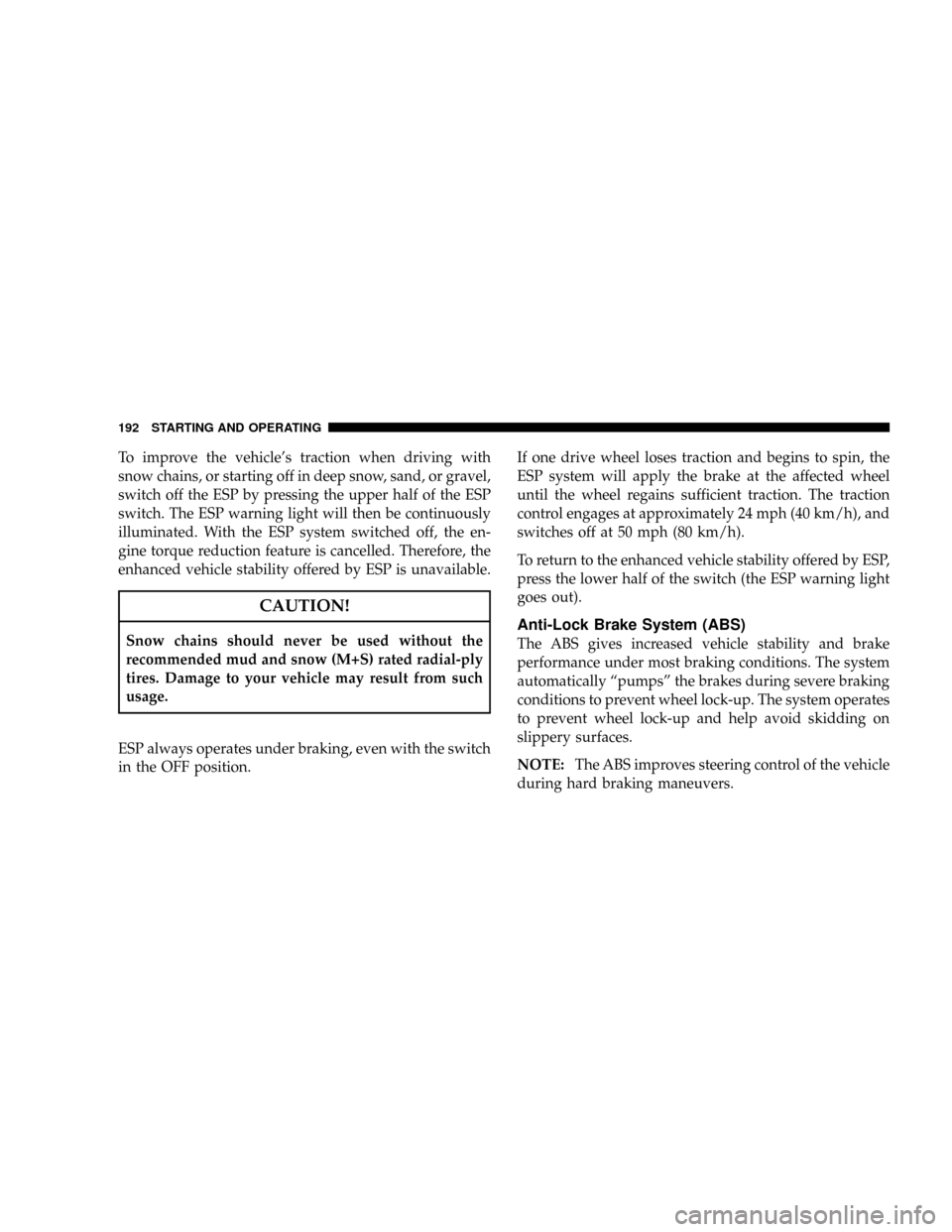
To improve the vehicle's traction when driving with
snow chains, or starting off in deep snow, sand, or gravel,
switch off the ESP by pressing the upper half of the ESP
switch. The ESP warning light will then be continuously
illuminated. With the ESP system switched off, the en-
gine torque reduction feature is cancelled. Therefore, the
enhanced vehicle stability offered by ESP is unavailable.
CAUTION!
Snow chains should never be used without the
recommended mud and snow (M+S) rated radial-ply
tires. Damage to your vehicle may result from such
usage.
ESP always operates under braking, even with the switch
in the OFF position.If one drive wheel loses traction and begins to spin, the
ESP system will apply the brake at the affected wheel
until the wheel regains sufficient traction. The traction
control engages at approximately 24 mph (40 km/h), and
switches off at 50 mph (80 km/h).
To return to the enhanced vehicle stability offered by ESP,
press the lower half of the switch (the ESP warning light
goes out).Anti-Lock Brake System (ABS)
The ABS gives increased vehicle stability and brake
performance under most braking conditions. The system
automatically ªpumpsº the brakes during severe braking
conditions to prevent wheel lock-up. The system operates
to prevent wheel lock-up and help avoid skidding on
slippery surfaces.
NOTE:The ABS improves steering control of the vehicle
during hard braking maneuvers.
192 STARTING AND OPERATING
Page 195 of 358
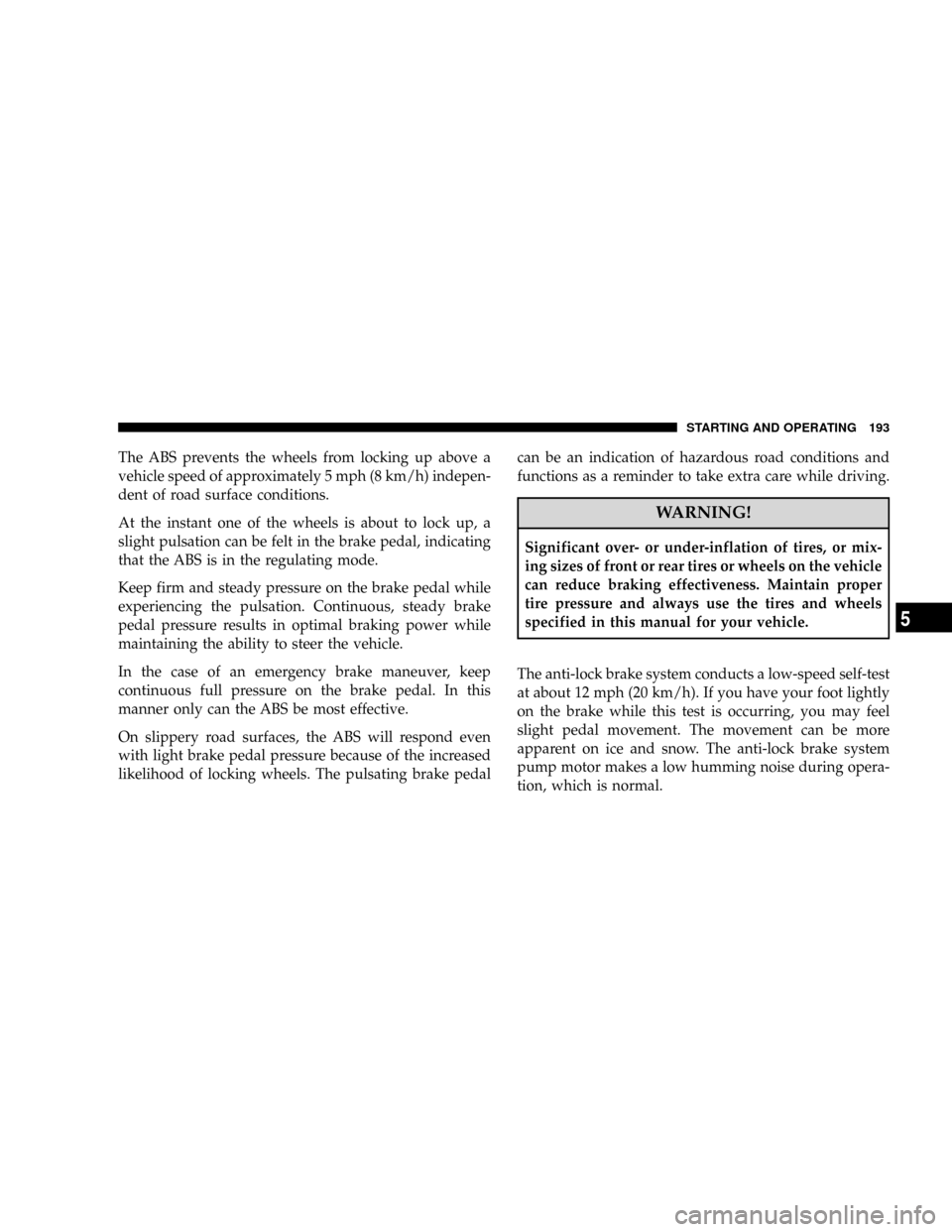
The ABS prevents the wheels from locking up above a
vehicle speed of approximately 5 mph (8 km/h) indepen-
dent of road surface conditions.
At the instant one of the wheels is about to lock up, a
slight pulsation can be felt in the brake pedal, indicating
that the ABS is in the regulating mode.
Keep firm and steady pressure on the brake pedal while
experiencing the pulsation. Continuous, steady brake
pedal pressure results in optimal braking power while
maintaining the ability to steer the vehicle.
In the case of an emergency brake maneuver, keep
continuous full pressure on the brake pedal. In this
manner only can the ABS be most effective.
On slippery road surfaces, the ABS will respond even
with light brake pedal pressure because of the increased
likelihood of locking wheels. The pulsating brake pedalcan be an indication of hazardous road conditions and
functions as a reminder to take extra care while driving.
WARNING!
Significant over- or under-inflation of tires, or mix-
ing sizes of front or rear tires or wheels on the vehicle
can reduce braking effectiveness. Maintain proper
tire pressure and always use the tires and wheels
specified in this manual for your vehicle.
The anti-lock brake system conducts a low-speed self-test
at about 12 mph (20 km/h). If you have your foot lightly
on the brake while this test is occurring, you may feel
slight pedal movement. The movement can be more
apparent on ice and snow. The anti-lock brake system
pump motor makes a low humming noise during opera-
tion, which is normal.
STARTING AND OPERATING 193
5
Page 199 of 358
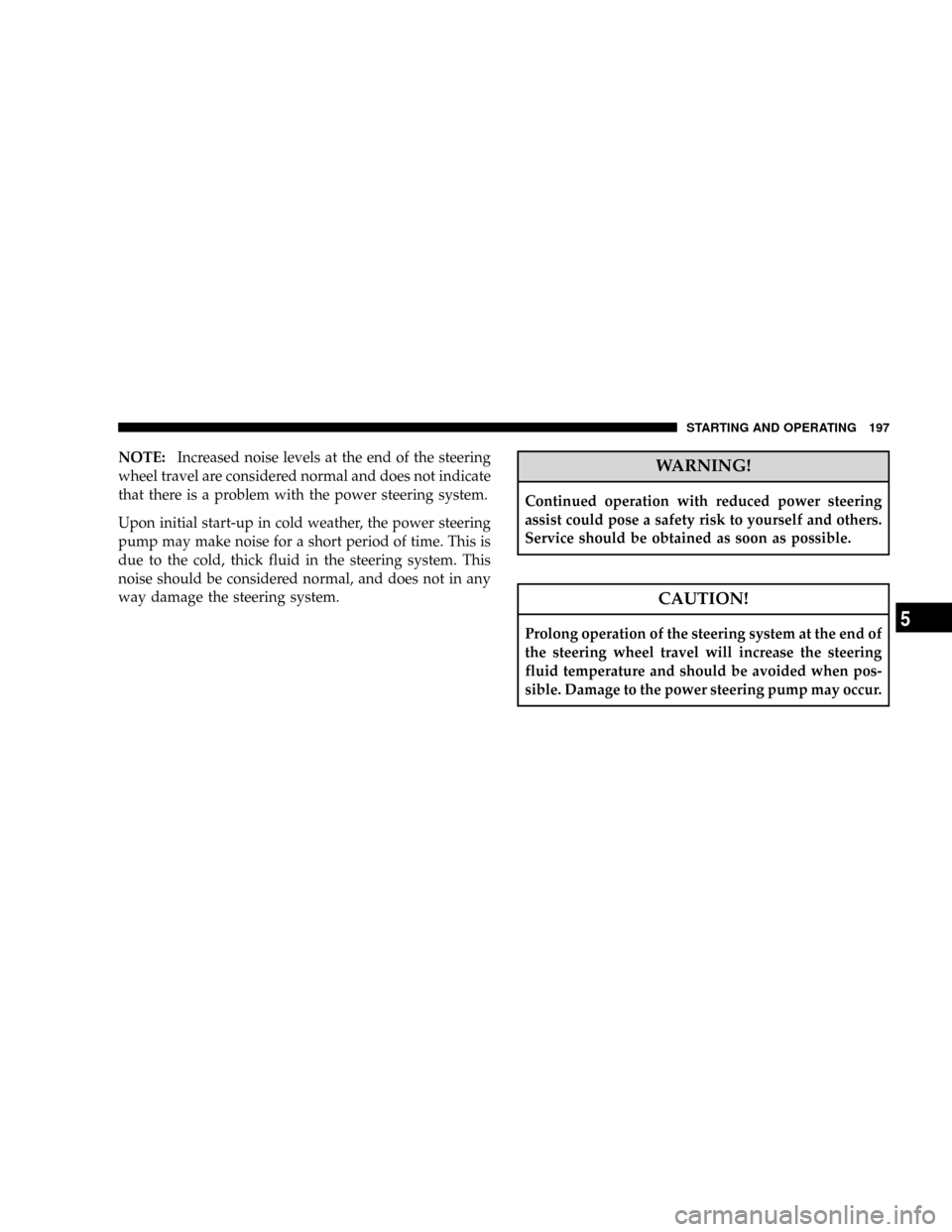
NOTE:Increased noise levels at the end of the steering
wheel travel are considered normal and does not indicate
that there is a problem with the power steering system.
Upon initial start-up in cold weather, the power steering
pump may make noise for a short period of time. This is
due to the cold, thick fluid in the steering system. This
noise should be considered normal, and does not in any
way damage the steering system.WARNING!
Continued operation with reduced power steering
assist could pose a safety risk to yourself and others.
Service should be obtained as soon as possible.
CAUTION!
Prolong operation of the steering system at the end of
the steering wheel travel will increase the steering
fluid temperature and should be avoided when pos-
sible. Damage to the power steering pump may occur.
STARTING AND OPERATING 197
5
Page 213 of 358
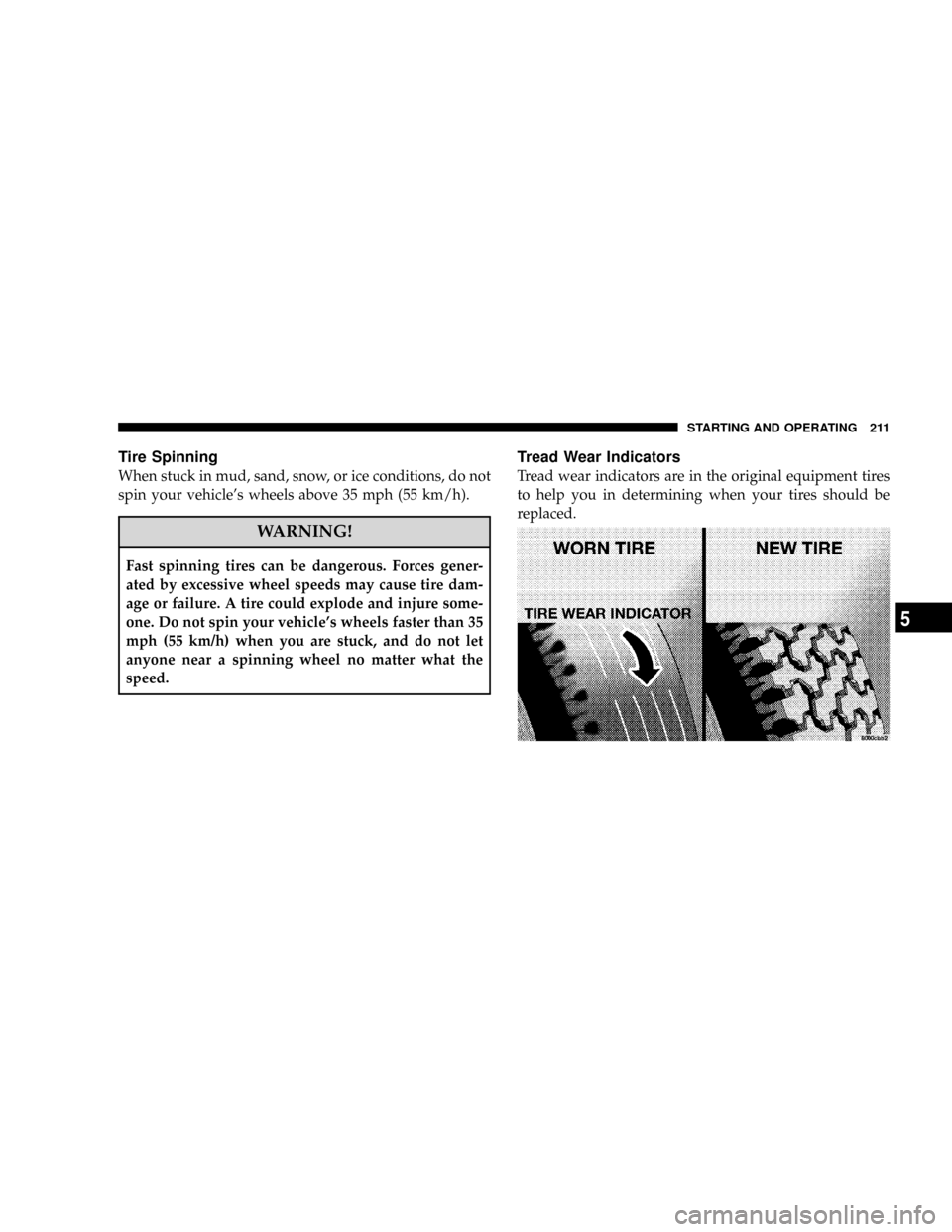
Tire Spinning
When stuck in mud, sand, snow, or ice conditions, do not
spin your vehicle's wheels above 35 mph (55 km/h).
WARNING!
Fast spinning tires can be dangerous. Forces gener-
ated by excessive wheel speeds may cause tire dam-
age or failure. A tire could explode and injure some-
one. Do not spin your vehicle's wheels faster than 35
mph (55 km/h) when you are stuck, and do not let
anyone near a spinning wheel no matter what the
speed.
Tread Wear Indicators
Tread wear indicators are in the original equipment tires
to help you in determining when your tires should be
replaced.
STARTING AND OPERATING 211
5
Page 215 of 358
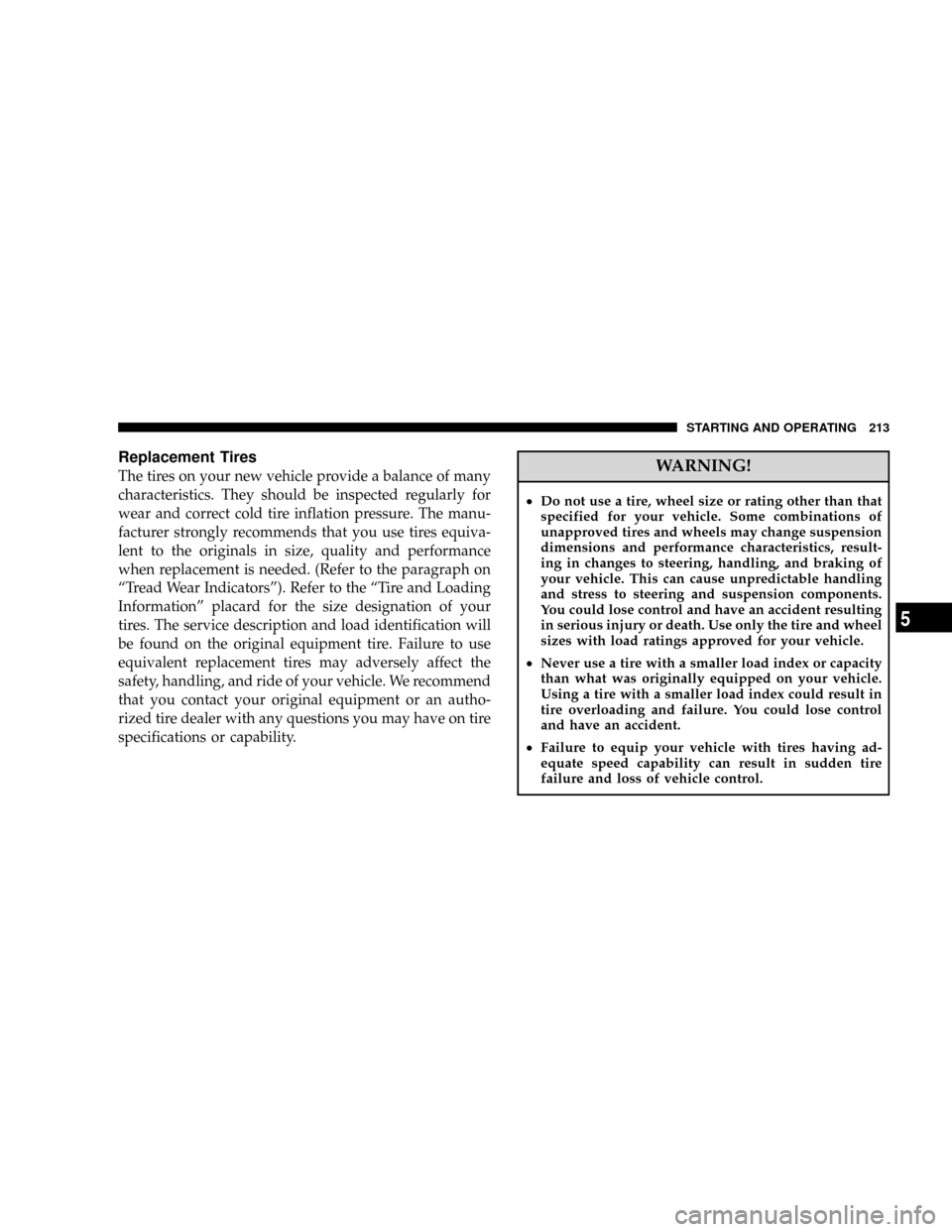
Replacement Tires
The tires on your new vehicle provide a balance of many
characteristics. They should be inspected regularly for
wear and correct cold tire inflation pressure. The manu-
facturer strongly recommends that you use tires equiva-
lent to the originals in size, quality and performance
when replacement is needed. (Refer to the paragraph on
ªTread Wear Indicatorsº). Refer to the ªTire and Loading
Informationº placard for the size designation of your
tires. The service description and load identification will
be found on the original equipment tire. Failure to use
equivalent replacement tires may adversely affect the
safety, handling, and ride of your vehicle. We recommend
that you contact your original equipment or an autho-
rized tire dealer with any questions you may have on tire
specifications or capability.WARNING!
²Do not use a tire, wheel size or rating other than that
specified for your vehicle. Some combinations of
unapproved tires and wheels may change suspension
dimensions and performance characteristics, result-
ing in changes to steering, handling, and braking of
your vehicle. This can cause unpredictable handling
and stress to steering and suspension components.
You could lose control and have an accident resulting
in serious injury or death. Use only the tire and wheel
sizes with load ratings approved for your vehicle.
²Never use a tire with a smaller load index or capacity
than what was originally equipped on your vehicle.
Using a tire with a smaller load index could result in
tire overloading and failure. You could lose control
and have an accident.
²Failure to equip your vehicle with tires having ad-
equate speed capability can result in sudden tire
failure and loss of vehicle control.
STARTING AND OPERATING 213
5
Page 216 of 358
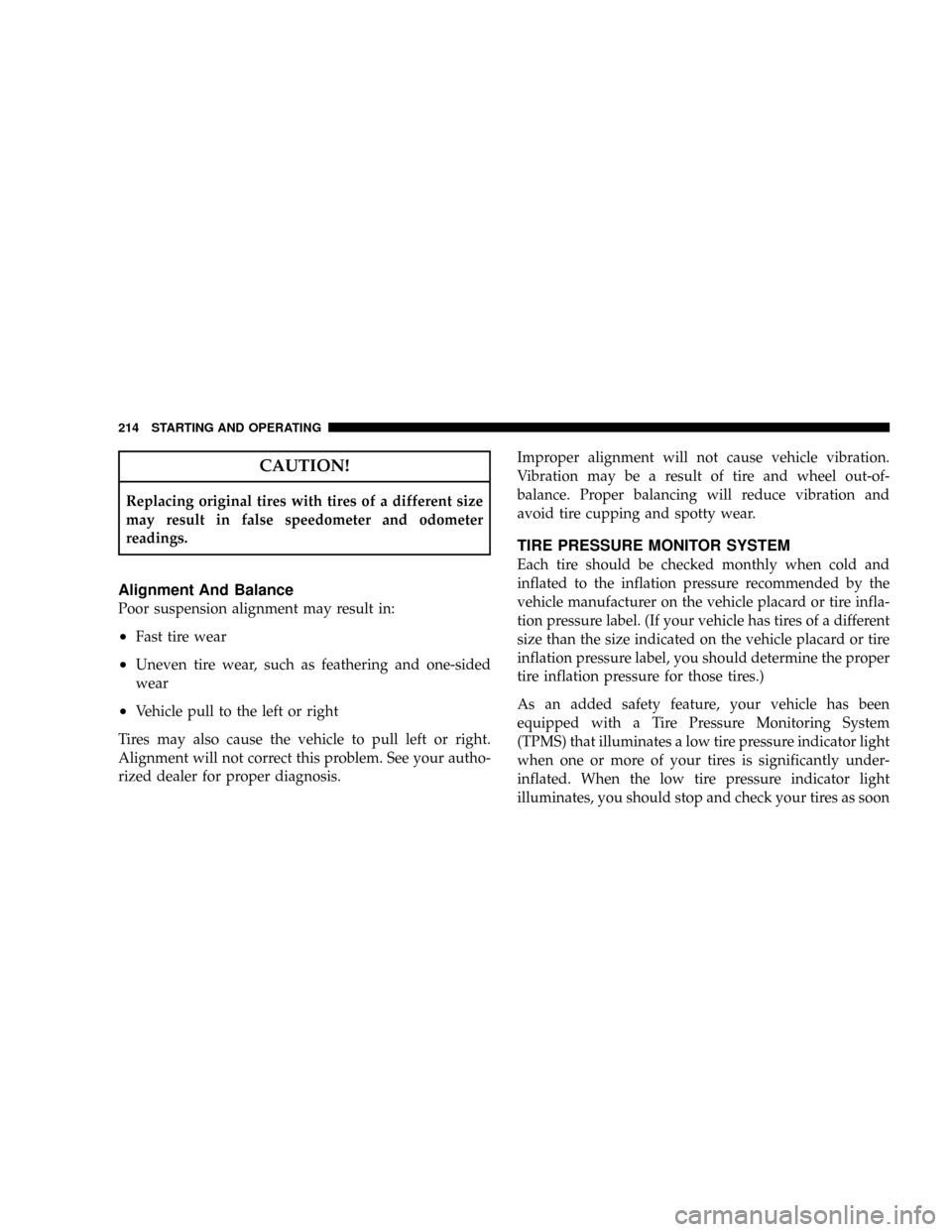
CAUTION!
Replacing original tires with tires of a different size
may result in false speedometer and odometer
readings.
Alignment And Balance
Poor suspension alignment may result in:
²Fast tire wear
²Uneven tire wear, such as feathering and one-sided
wear
²Vehicle pull to the left or right
Tires may also cause the vehicle to pull left or right.
Alignment will not correct this problem. See your autho-
rized dealer for proper diagnosis.Improper alignment will not cause vehicle vibration.
Vibration may be a result of tire and wheel out-of-
balance. Proper balancing will reduce vibration and
avoid tire cupping and spotty wear.
TIRE PRESSURE MONITOR SYSTEM
Each tire should be checked monthly when cold and
inflated to the inflation pressure recommended by the
vehicle manufacturer on the vehicle placard or tire infla-
tion pressure label. (If your vehicle has tires of a different
size than the size indicated on the vehicle placard or tire
inflation pressure label, you should determine the proper
tire inflation pressure for those tires.)
As an added safety feature, your vehicle has been
equipped with a Tire Pressure Monitoring System
(TPMS) that illuminates a low tire pressure indicator light
when one or more of your tires is significantly under-
inflated. When the low tire pressure indicator light
illuminates, you should stop and check your tires as soon
214 STARTING AND OPERATING
Page 217 of 358
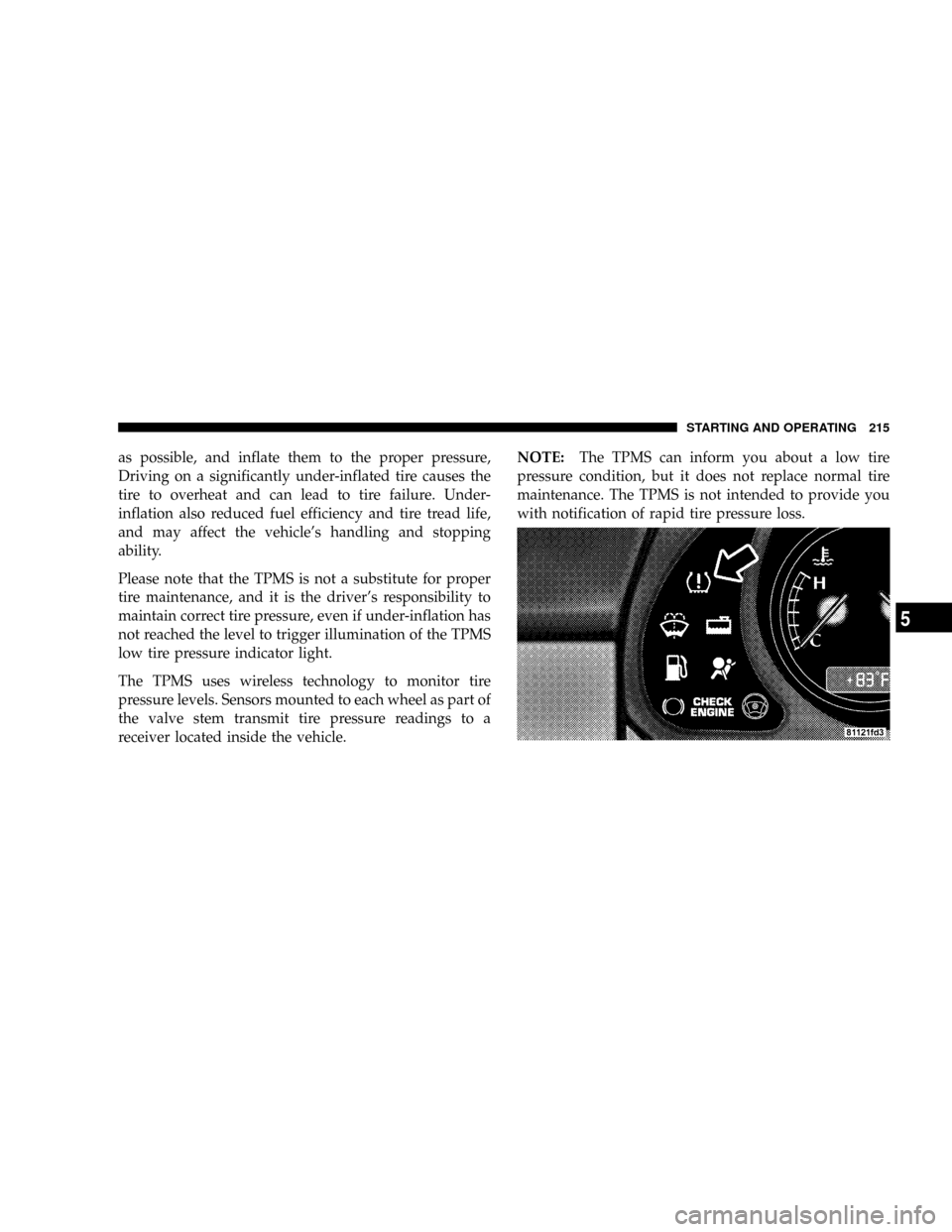
as possible, and inflate them to the proper pressure,
Driving on a significantly under-inflated tire causes the
tire to overheat and can lead to tire failure. Under-
inflation also reduced fuel efficiency and tire tread life,
and may affect the vehicle's handling and stopping
ability.
Please note that the TPMS is not a substitute for proper
tire maintenance, and it is the driver's responsibility to
maintain correct tire pressure, even if under-inflation has
not reached the level to trigger illumination of the TPMS
low tire pressure indicator light.
The TPMS uses wireless technology to monitor tire
pressure levels. Sensors mounted to each wheel as part of
the valve stem transmit tire pressure readings to a
receiver located inside the vehicle.NOTE:The TPMS can inform you about a low tire
pressure condition, but it does not replace normal tire
maintenance. The TPMS is not intended to provide you
with notification of rapid tire pressure loss.
STARTING AND OPERATING 215
5
Page 219 of 358
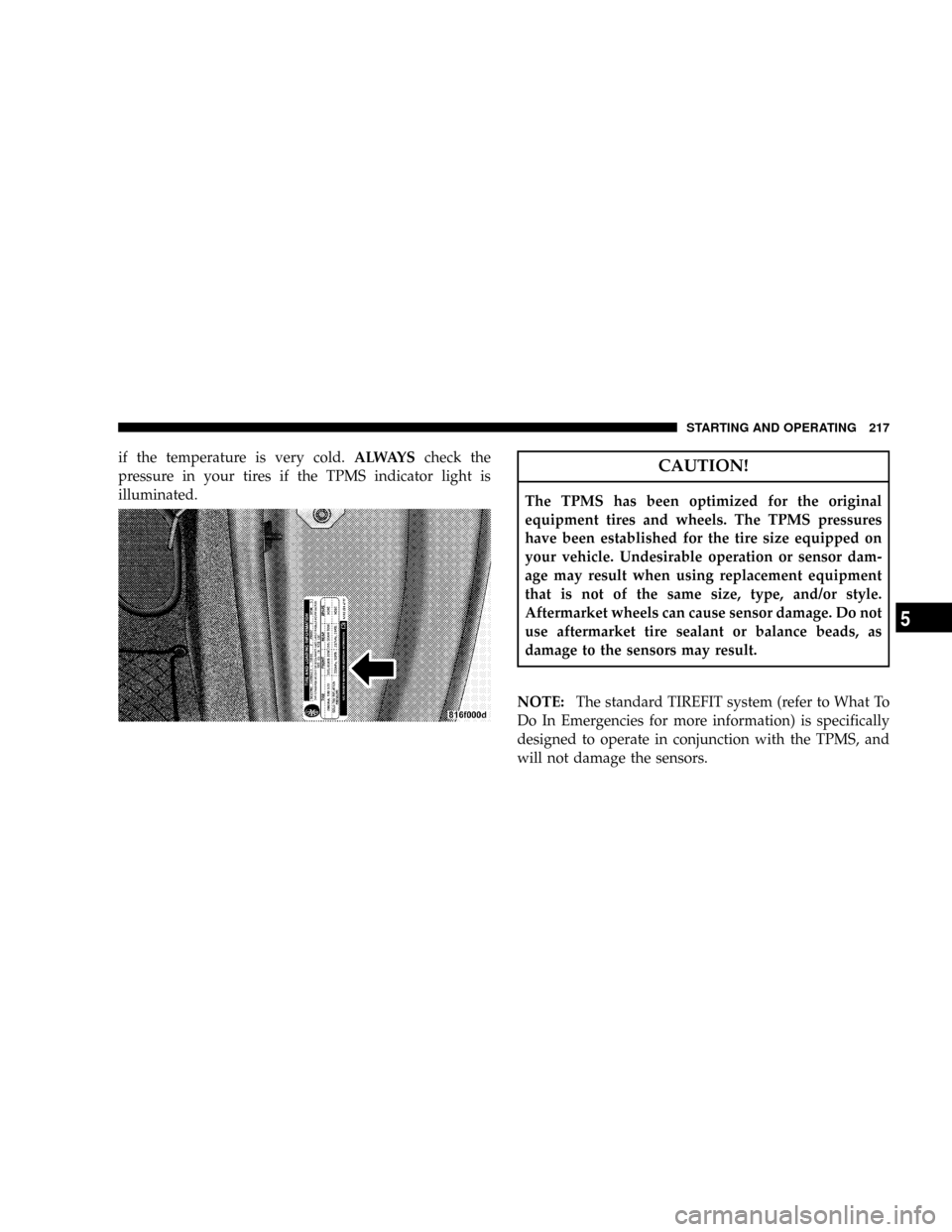
if the temperature is very cold.ALWAYScheck the
pressure in your tires if the TPMS indicator light is
illuminated.CAUTION!
The TPMS has been optimized for the original
equipment tires and wheels. The TPMS pressures
have been established for the tire size equipped on
your vehicle. Undesirable operation or sensor dam-
age may result when using replacement equipment
that is not of the same size, type, and/or style.
Aftermarket wheels can cause sensor damage. Do not
use aftermarket tire sealant or balance beads, as
damage to the sensors may result.
NOTE:The standard TIREFIT system (refer to What To
Do In Emergencies for more information) is specifically
designed to operate in conjunction with the TPMS, and
will not damage the sensors.
STARTING AND OPERATING 217
5